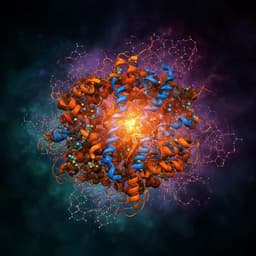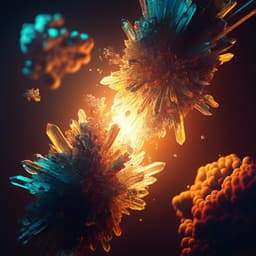
Chemistry
Designed Rubredoxin miniature in a fully artificial electron chain triggered by visible light
M. Chino, L. F. D. Costanzo, et al.
Exciting advancements in the design of metal sites in *de novo* proteins are showcased by a team of researchers including Marco Chino, Luigi Franklin Di Costanzo, and others. Their innovative 28-residue tetra-thiolate metal-binding protein exhibits remarkable precision and high reduction potential, making it a groundbreaking component in artificial light-triggered electron chains.
~3 min • Beginner • English
Introduction
Electron transport chains underlie key biological processes from respiration to light harvesting and rely on redox-active metalloproteins whose metal centers and surrounding residues tune redox potentials and electron transfer. Designing de novo redox-active metal sites that are finely tunable and support photo-induced electron transfer remains challenging, particularly when aiming for minimal coordination environments. Rubredoxins, with a simple FeCys4 center and small size, provide an ideal benchmark. This study seeks to define the minimal structural elements necessary to recreate a functional FeCys4 center in a highly miniaturized 28-residue scaffold, achieve high redox potential via second-sphere interactions, and demonstrate its function as a terminal electron acceptor in a fully artificial, visible-light-triggered electron transfer chain.
Literature Review
Prior efforts in de novo and engineered metalloproteins include synthetic porphyrin-based proteins (Mimochromes) used for electron transfer and catalysis, and designed ferredoxins and cytochromes enabling intra- and inter-protein ET. Natural redox proteins modulating bioenergetics include cupredoxins, cytochromes, and iron–sulfur proteins; rubredoxins are the simplest, binding Fe via four cysteines with potentials typically −100 to +50 mV (up to ~125 mV in eukaryotes and higher in rubrerythrin-like domains). Reduction potentials in rubredoxin variants correlate with second-sphere hydrogen bonds to sulfur ligands and peptide dipole orientation. Previous rubredoxin mimics have used cyclic peptides or three-helix bundles and often larger scaffolds, sometimes requiring stabilizing motifs or cyclization. Miniaturization approaches (e.g., METP scaffolds) and incorporation of Aib to induce 3₁₀-helix segments have aided stability and folding. However, achieving a tetra-thiolate Fe site with sub-Å design accuracy and targeted high potential in a very small single-chain protein remained unproven.
Methodology
Design and modeling: The reduced Clostridium pasteurianum rubredoxin V44A mutant (PDB 1C09) served as template. The Val38–Glu50 segment was extracted and duplicated via a C2 longitudinal rotation to create a symmetric dimer. A fragment search identified 4-residue loops to link termini (39/158 hits; predominantly β-turns, with type I′/III′ enriched and Gly at i+1/i+2). The best loop was grafted to form a single-chain prototype. Rosetta-based flexible-backbone and side-chain packing design incorporated constraints from preliminary analyses; Aib residues were fixed at positions 9 and 24 to promote 3₁₀-helix formation. Hydrophilic residues were enforced in CXXC motifs. Monte Carlo sampling (300 runs) yielded the lowest-energy model with intended first- and second-sphere interactions.
Synthesis and purification: METPsc1 (28 residues; acetylated N-terminus and amidated C-terminus) was synthesized by Fmoc SPPS on H-PAL ChemMatrix resin (0.2 mmol/g) using HATU coupling. N-terminus was acetylated (acetic anhydride/HOBt/DIEA). Cleavage/deprotection used TFA/H2O/TIS/ethanedithiol (9.4:0.25:0.25:0.1). Crude yield ~65% (50% HPLC purity). Peptide was purified by preparative RP-HPLC (H2O/0.1% TFA–ACN/0.1% TFA gradient) and characterized by RP-HPLC-MS (ESI-MS).
Crystallography: ZnMETPsc1 was crystallized (hanging drop, 20 °C) from protein solution (10 mg/mL, 7 mM DTT, 4 mM ZnCl2) mixed 1:1 with precipitant (0.1 M HEPES pH 7.5, 1.4 M sodium citrate tribasic). Crystals grew in C2221; data collected at 1.34 Å (100 K, λ = 1.2400 Å, Elettra XRD1). Structure solved by MR (Phaser) using the designed model (without termini); refined anisotropically in Phenix with manual rebuilding in Coot; 26 waters placed.
Spectroscopy: UV–Vis spectra recorded at 25 °C in sealed Ar-purged quartz cuvettes (1 cm). Apo-METPsc1 (30 µM, HEPES 20 mM, pH 7, 1 mM TCEP) was titrated with Fe2+ (Mohr’s salt) in ~0.1 equiv aliquots. Redox cycling monitored at 494 nm with sequential air purge (oxidation) and dithionite reduction under Ar. CD spectra (300–800 nm) were acquired for oxidized and reduced forms (40 µM, HEPES 20 mM, pH 7). EPR: Fe3+METPsc1 (~0.5 mM in 20 mM phosphate pH 7, 5 mM TCEP, 30% glycerol) measured by X-band CW-EPR at 4.5 K (9.76 GHz, 1 mW, 0.7 mT modulation, 100 kHz).
Electrochemistry: Cyclic voltammetry at 15 °C under Ar using a three-electrode cell (GCE 3 mm working, Pt counter, Ag/AgCl 3 M NaCl reference; 0.206 V). FeMETPsc1 reconstituted on a membrane at the electrode, then measured in 20 mM HEPES, 0.3 M KCl, pH 7, scan rates 2.5–50 mV/s. Randles–Ševčík analysis used to estimate diffusion coefficients; HYDRONMR used for hydrodynamic estimate from the crystal model.
Photo-induced electron transfer: A solution containing FeMETPsc1, ZnMC6*a (Zn-porphyrin mini-protein photosensitizer), and triethylamine (TEA, sacrificial donor) in HEPES pH 7 was first oxidized by air, then Ar-purged and irradiated with green LEDs (λmax ~570 nm, ~5 mW/cm2 per LED) for 20 min. UV–Vis monitored changes at 494 nm (Fe3+METPsc1 CT band) and 311 nm (Fe2+METPsc1 band). Cycling with alternating air exposure and irradiation was assessed; control irradiation of ZnMC6*a alone was also performed.
Key Findings
- Structural accuracy: The crystallographic structure of ZnMETPsc1 matches the design with backbone RMSD ~0.45 Å, preserving intended first- and second-sphere interactions and overall fold in a 28-residue single-chain.
- Metal site geometry: Zn2+ is tetrahedrally coordinated by four Cys Sγ atoms with average Sγ–Zn distance 2.34 ± 0.03 Å and Sγ–Zn–Sγ angles 109 ± 4°, consistent with rubredoxins. First-sphere Cys side-chain arrangements and torsions mirror natural Rds (e.g., Sγ(Cys2)–Zn–Sγ–Cβ(Cys17) ~180°, and the pseudo-symmetric torsion ~159°).
- Second-sphere H-bonding: Backbone N–H donors (Asp4, Cys5, Asn19, Cys20) and strategically small residues Ala7 and Ala22 provide H-bonds to the Cys Sγ atoms, designed to lower S electron density and favor higher redox potential.
- Iron binding and spectra: UV–Vis titration indicates tight 1:1 binding of Fe2+ with characteristic bands; Fe3+METPsc1 shows a CT band at 494 nm, while Fe2+METPsc1 exhibits a band at 311 nm. CD spectra differ between oxidation states, consistent with FeCys4 environment.
- EPR: X-band CW-EPR of Fe3+METPsc1 reveals geff ≈ 9.15 and 4.26, indicative of high-spin Fe3+ (S = 5/2) with rhombicity E/D ≈ 0.22 and positive D, consistent with sulfur ligation as in natural Rds.
- Redox cycling robustness: The Fe center switches reversibly between Fe2+ and Fe3+ through at least 12 cycles over two days with ≈92% signal recovery in the last oxidation step and no detectable loss when stored under Ar overnight.
- Electrochemistry: Cyclic voltammetry shows quasi-reversible behavior with E0 = +121 mV vs SHE (ΔEp 59–136 mV) at scan rates 2.5–50 mV/s. Diffusion coefficients derived by Randles–Ševčík: Dred = 0.92 × 10−6 cm2 s−1 and Dox = 1.4 × 10−6 cm2 s−1, in reasonable agreement with HYDRONMR estimate (~1.47 × 10−6 cm2 s−1).
- Photo-induced ET: In the presence of ZnMC6*a (5 µM) and TEA (2 mM), green light irradiation (20 min, Ar atmosphere) reduces Fe3+METPsc1 (40 µM), evidenced by loss of the 494 nm band and appearance of the 311 nm band. Controls in the dark show only ~10% decrease at 494 nm over 30 min. Repeated air/irradiation cycles show partial reduction in later cycles due to ZnMC6*a degradation.
- Functional outcome: The designed mini-protein achieves one of the highest reported rubredoxin-like reduction potentials and functions as a terminal electron acceptor in a fully artificial, visible-light-driven electron cascade.
Discussion
The study demonstrates that a minimal, 28-residue scaffold can be engineered to precisely fold around a tetra-thiolate metal site and reproduce the geometry and electronic structure of rubredoxin. The sub-Å agreement between design and crystal structure validates the design strategy based on symmetry miniaturization and targeted second-sphere hydrogen bonds. The strong correlation between the engineered second-sphere H-bond network (Ala7, Ala22, Asn19, Arg27/backbone donors) and the elevated reduction potential (E0 = +121 mV vs SHE) confirms that subtle second-sphere tuning can favor the ferrous state and modulate redox properties, surpassing typical prokaryotic Rd potentials and approaching rubrerythrin domains. Functionally, FeMETPsc1 acts as an efficient, reversible redox center and, when coupled with a Zn-porphyrin mini-protein photosensitizer and TEA, serves as the terminal electron acceptor in a fully artificial, visible-light-triggered electron transfer chain. These results substantiate the concept that de novo miniaturization can isolate essential determinants of metal-site behavior, enabling precise control over redox potential and ET functionality. The approach is generalizable, relying on the mutual orientation of C2-related motifs without requiring specific supersecondary motifs or cyclization, and provides a foundation for constructing nanoscale, multi-component protein devices for bioenergy and catalysis.
Conclusion
This work delivers a de novo 28-residue mini-protein (METPsc1) that accurately reproduces a tetra-thiolate metal site with sub-Å design fidelity, achieves a high rubredoxin-like reduction potential (121 mV vs SHE), and operates as a terminal acceptor in an artificial, light-driven electron transfer cascade. The design principles—symmetry-based miniaturization and targeted second-sphere H-bonding—enable precise tuning of redox properties and establish a broadly applicable methodology for building minimal metalloproteins. Future directions include integrating multiple designed cofactors into modular nano-sized assemblies, enhancing photosensitizer stability to improve cycling, expanding the range of targeted redox potentials and activities, and leveraging computational and machine learning tools to further refine second-sphere interactions and dynamics.
Limitations
- Photosensitizer stability: Repeated photo-ET cycles showed incomplete Fe3+ reduction due to progressive ZnMC6*a degradation, likely from reactive oxygen species generated during O2 reduction or self-oxidation, limiting cycling robustness.
- Modeling energy function: Small discrepancies between relaxed design models and the minimized X-ray structure (RMSDs clustering ≥0.4 Å) suggest limitations in Rosetta’s metal-binding scoring/constraints.
- Structural scope: The crystal structure was obtained for the Zn2+ complex; while spectroscopy confirms Fe binding and geometry analogous to Rds, an Fe-bound crystal structure was not reported here.
- System generalizability under operating conditions: Demonstrations were in vitro under controlled buffer and gas conditions; performance in complex environments or device integration remains to be tested.
Related Publications
Explore these studies to deepen your understanding of the subject.







